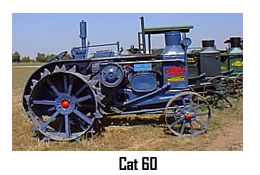 |
 All Classic Ads Vintage Collection - Caterpillar related ads All Classic Ads Vintage Collection - Caterpillar related ads
Ad • Ad

|
|
History of Caterpillar (1904)
Benjamin Holt was one of the first men to experiment the construction of steam tractors for farming use. Once he managed to build these steam-powered vehicles, he started selling them throughout California until the mid-'10s. In 1904, due to most of the tractors 'planting' themselves in the soft soil of California state because of their immense weight, Holt thought about adding wooden block-linked treads around idlers. After his experimental Holt No. 77, the Californian manufacturer introduced the much acclaimed Caterpillar 30 and Caterpillar 60 models. 
It was soon very clear that Holt needed a factory in order to enter the American tractor market and rationalize his production. Therefore, in 1909, he purchased a manufacturing plant in Peoria, Illinois. Two years later, the Caterpillar factory had no less than 625 people on the payroll and the company was starting to go international (exporting tractors in Argentina, Mexico and Canada). 
The Holt Manufacturing Company successfully continued its production process during the following decade, including supplying the US Army with caterpillar tracks (for tank usage) and crawler tractors.
In 1925, Holt Manufacturing Company and C.L. Best Gas Traction Company (San Leandro, California) merged to form the new Caterpillar Company. The new line of production brought in 13 million dollars worth of sales, with the company's profits quadrupling in the following 4 years. Also, during The Great Depression, Caterpillar began introducing diesel engines on their tractor assembly line. As a result of that, the new Diesel Sixty Tractor was launched in East Peoria, Illinois.
During WWII, Caterpillar extended their production line and started manufacturing from motor graders, blade graders and elevating graders to terracers and electrical generating sets. Most of these new products were designed to help the US Army in their war operations throughout the early '40s.
Caterpillar opened its first overseas base in 1950, when Caterpillar Tractor Co. Ltd is launched in Great Britain. Three years later, the company opened a separate sales & marketing division to better develop the engine sales – accountable for one third of company's overall revenues.
Caterpillar continued extending outside the United States in the following decade, joining forces with Japanese manufacturer Mitsubishi for a new partial-ownership in Caterpillar Mitsubishi Ltd. The new plant started assembling their first line of production in 1963 and quickly developed itself as one of the top construction-products manufacturer in Japan. The company later changed its name into Shin Caterpillar Mitsubishi Ltd.
The early '80s were going to be very difficult for Caterpillar, especially since the company was very close to filing for bankruptcy due to poor sales. The American manufacturer was clearly losing in their battle with Japanese company Komatsu on the construction market and was reportedly losing about $1 million a day in 1980. This caused a dramatic fall in employment and the political situation was not helping either. Following Ronald Reagan's embargo against the Soviet Union, Caterpillar lost more than $400 million – as the company was unable to deliver their pipe-laying products to their Russian customers.
Caterpillar found two simple solutions to fighting the labor union strikes – which were quite frequent at the time. First, they re-organized their line of production and focused more on the tools market. Second, the company opened strategic small plants in southern USA (North Carolina, South Carolina, Mississippi, Tennessee and Georgia), where labor laws were not as strict.
Soon after changing its name from Caterpillar Tractor Co. into Caterpillar Inc. - as the line of production included an immense range of engines & construction equipments – the company launched a $1.8-billion plant modernization program to develop its manufacturing process.
The beginning of the '90s meant another reorganization of Caterpillar Inc., with the company decentralizing its structure in various business units. In 1996, Caterpillar purchased German company MaK Motoren and followed that move with acquiring UK's Perkins Engines. This way, Caterpillar Inc. became world's undisputed leader in diesel engine production.
In 1998, the company introduces the largest off-highway truck at the Cat Proving Ground (Arizona), the Model 797. Five years later, Caterpillar announces that all their 2004 models would be equipped with a new-generation ACERT diesel engines.
In 2006, Benjamin Holt – Caterpillar founder – took his place in the National Inventors Hall of Fame for creating the first track-type tractor. The same year, Caterpillar opened a new distribution center in Shanghai through Caterpillar Logistics Services Inc. subsidiary.
AVAILABLE Caterpillar ADS BY DATE AND CATEGORY
AVAILABLE CANDY ADS BY DATE AND CATEGORY
1900 - 1919 |
1940 - 1949 |
1970 - 1979 |
|
|
|
1920 - 1929 |
1950 - 1959 |
1980 - 1989 |
|
|
|
1930 - 1939 |
1960 - 1969 |
1990 - 1999 |
|
|
|
 |
Size -
Grading -
Availability -
Price -
Publishing Date:
Magazine:
Shipping and handling fees - verify postal code
Catalog ID:

|
 |
Size -
Grading -
Availability -
Price -
Publishing Date:
Magazine:
Shipping and handling fees - verify postal code
Catalog ID:

|
|
|



